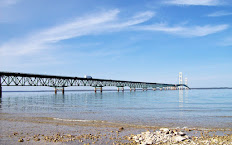 Isle Royale wolves in winter. Wolves first came to Isle Royale in about the year 1950 by walking on an ice bridge from Canada. (Photo © and courtesy J. Vucetich. Reprinted with permission.)
Isle Royale wolves in winter. Wolves first came to Isle Royale in about the year 1950 by walking on an ice bridge from Canada. (Photo © and courtesy J. Vucetich. Reprinted with permission.)By Peter Mayer*
HOUGHTON -- Isle Royale National Park is a wild place, the dwelling of prowling wolf packs and foraging moose. Isolated from the mainland by at least 15 miles of Lake Superior water, the island provides an invaluable setting for passionate researchers. Ecologist John Vucetich and Wildlife Ecologist Rolf Peterson co-lead the Michigan Technological University research team that studies wolf and moose interaction, producing knowledge relevant to understanding ecosystems all over the world.
 Isle Royale wolf. (Photo © and courtesy J. Vucetich. Reprinted with permission.)
Isle Royale wolf. (Photo © and courtesy J. Vucetich. Reprinted with permission.)According to Vucetich, the archipelago is an optimal location for gathering information on species interaction. The limited diversity of species supplies a much simpler ecosystem than is typical of continental environments. Wolves are the only predator to moose and moose comprise 90 percent of the wolf diet. Because of this, the single-prey-single-predator system can be studied intimately.
"It’s important when we manage natural systems in various parts of the world to understand how they work," Vucetich said. "Isle Royale is one of these places that we can watch for a long time . . . it’s a relatively simple system. There are fewer components here."
The simplicity of that single predator system makes it easier to understand what’s going on, he added.
Vucetich, Peterson and their team have generated data that has various biological implications. Their research has produced considerable insight into wolf mortality rates, the functioning of wolf predation on moose, and the effects of wolf predation on prey populations. This information can be applied to the relationships of predator-prey populations in a variety of ecosystems.
The project has been going on for 50 years, the longest predator-based study in the world. Vucetich, who has been working on the team for 19 years, said the study's longevity reinforces its importance.
"The more we study," Vucetich said, "the more we realize how poor previous studies were . . . these first 50 years are going to be different than the next 50 years. It’s kind of a scientific exercise in humility that lets us know that if you watch something for a short while, you may get the wrong impression."
 Isle Royale moose. (Photo © and courtesy J. Vucetich. Reprinted with permission.)
Isle Royale moose. (Photo © and courtesy J. Vucetich. Reprinted with permission.)When Isle Royale became a national park in 1931, moose had already lived there for 30-some years after swimming across Lake Superior from Canada; but wolves did not inhabit the island for another 20 years, crossing the Lake Superior ice to arrive at their new home. In 1974, the gray wolf population had been confined to a small area of northern Minnesota and Isle Royale.
"Rolf began working on the project in the early 1970s," Vucetich noted. "Over the decades his observations have led to great insights about how nature works -- everything from learning the wolves have a strong preference for old and weak moose to using moose bones to discover that poor nutrition early in life increases the risk of arthritis later in life. Rolf retired from Michigan Tech University a few years ago, but his commitment to the wolves and moose is as strong as ever."**
Wolves are currently on the U.S. Endangered Species List, which protects them as a non-game species. On May 4, 2009, wolves were temporarily delisted in the Western Great Lakes region, but the U.S. Fish and Wildlife Service withdrew the delisting on July 1, 2009.
A number of Upper Peninsula sportsmen believe wolves cause deer scarcity in different parts of the region and reduced hunting success. The perceived reduction in deer numbers has stirred a debate over the protective status of wolves. The Department of Natural Resources and Environment (DNRE) estimated the wolf population at 577 in the UP, an 11 percent increase over the previous year, according to the 2009 DNRE Wolf Management Report. As long as Isle Royale is studied, models can be produced for sustainable management of wolf populations in the U.P.
The wolf-moose research team is motivated by a scientific and philosophical respect for the natural world as well as an appreciation for the beauty of the island. The importance of Isle Royale as a nature preserve cannot be overstated, Vucetich said.
"The primary value for wolves on Isle Royale (is) the large number of visitors that come to the island and appreciate knowing there are wolves here and appreciate knowing how their populations work," Vucetich said.
For the scientist and the visitor, Isle Royale is truly a gem in the middle of the largest (in surface area) lake in the world. Its beauty is awe-inspiring, its conditions hospitable to its inhabitants, and its value as a nature preserve make it a rare and flourishing legacy of the U.S. conservation movement.***
Editor's Notes:
Update: Setting it straight: We regret a previous error in this article, which has now been corrected. Both Rolf Peterson and John Vucetich are co-leaders of the research team for the Isle Royale Wolf-Moose study.
* Visiting reporter Peter Mayer wrote this article as part of his work in David Clanaugh's summer journalism class at Michigan Tech. This is Mayer's second article for Keweenaw Now. See also his July 28 article, "Local soccer league promotes diversity, camaraderie among kids from different schools."
** See the Aug. 16, 2010 article "Michigan Tech ecologists link early malnutrition, later arthritis in Moose," by Jennifer Donovan, on the Michigan Tech Web site.
*** For more information on the Wolf-Moose study, visit their updated Web site, The Wolves and Moose of Isle Royale.

































































































































No comments:
Post a Comment